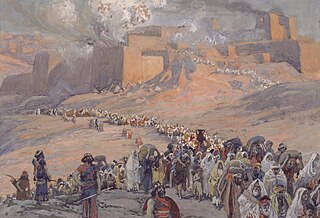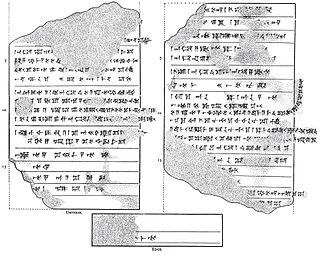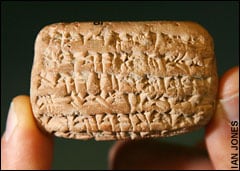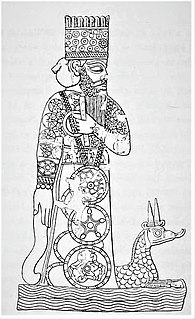 W
WBabylonia was an ancient Akkadian-speaking state and cultural area based in central-southern Mesopotamia which was part of Ancient Persia. A small Amorite-ruled state emerged in 1894 BCE, which contained the minor administrative town of Babylon. It was merely a small provincial town during the Akkadian Empire but greatly expanded during the reign of Hammurabi in the first half of the 18th century BCE and became a major capital city. During the reign of Hammurabi and afterwards, Babylonia was called "the country of Akkad", a deliberate archaism in reference to the previous glory of the Akkadian Empire.
 W
WAkitu or Akitum is a spring festival held in the first month of Nisanu in ancient Mesopotamia, to celebrate the sowing of barley. The Babylonian and Assyrian Akitu festival has played a pivotal role in the development of theories of religion, myth and ritual. While the purpose of the festival remains a point of contention among both historians of religion and Assyriologists, it is certain to have played a pivotal role in the regular setting of an agenda, priorities, and in the overall advancement of western civilization as being one of the first regularly occurring forums where proposals for social maintenance or change could consistently be made and crucial issues readily addressed.
 W
WAncient Mesopotamian units of measurement originated in the loosely organized city-states of Early Dynastic Sumer. Each city, kingdom and trade guild had its own standards until the formation of the Akkadian Empire when Sargon of Akkad issued a common standard. This standard was improved by Naram-Sin, but fell into disuse after the Akkadian Empire dissolved. The standard of Naram-Sin was readopted in the Ur III period by the Nanše Hymn which reduced a plethora of multiple standards to a few agreed upon common groupings. Successors to Sumerian civilization including the Babylonians, Assyrians, and Persians continued to use these groupings. Akkado-Sumerian metrology has been reconstructed by applying statistical methods to compare Sumerian architecture, architectural plans, and issued official standards such as Statue B of Gudea and the bronze cubit of Nippur.
 W
WThe Babylonian captivity or Babylonian exile is the period in Jewish history during which a number of people from the ancient Kingdom of Judah were captives in Babylon, the capital of the Neo-Babylonian Empire.
 W
WThe Babylonian Chronicles are a series of tablets recording major events in Babylonian history. They are thus one of the first steps in the development of ancient historiography. The Babylonian Chronicles were written in Babylonian cuneiform, from the reign of Nabonassar up to the Parthian Period, by Babylonian astronomers ("Chaldaeans"), who probably used the Astronomical Diaries as their source.
 W
WThe Babylonian Map of the World is a Babylonian clay tablet written in Akkadian containing a labeled depiction of the known world, with a short and partially lost description, dated to roughly the 6th century BC.
 W
WBabylonia was an ancient Akkadian-speaking state and cultural area based in central-southern Mesopotamia which was part of Ancient Persia. A small Amorite-ruled state emerged in 1894 BCE, which contained the minor administrative town of Babylon. It was merely a small provincial town during the Akkadian Empire but greatly expanded during the reign of Hammurabi in the first half of the 18th century BCE and became a major capital city. During the reign of Hammurabi and afterwards, Babylonia was called "the country of Akkad", a deliberate archaism in reference to the previous glory of the Akkadian Empire.
 W
WBabylonian religion is the religious practice of Babylonia. Babylonian mythology was greatly influenced by their Sumerian counterparts and was written on clay tablets inscribed with the cuneiform script derived from Sumerian cuneiform. The myths were usually either written in Sumerian or Akkadian. Some Babylonian texts were translations into Akkadian from the Sumerian language of earlier texts, although the names of some deities were changed.
 W
WChaldea was a country that existed between the late 10th or early 9th and mid-6th centuries BCE, after which the country and its people were absorbed and assimilated into Babylonia. Semitic-speaking, it was located in the marshy land of the far southeastern corner of Mesopotamia and briefly came to rule Babylon. The Hebrew Bible uses the term כשדים (Kaśdim) and this is translated as Chaldaeans in the Greek Old Testament, although there is some dispute as to whether Kasdim in fact means Chaldean or refers to the south Mesopotamian Kaldu.
 W
WThe Chronicle of Early Kings, Chronicle 20 in Grayson’s Assyrian and Babylonian Chronicles and Mesopotamian Chronicle 40 in Glassner’s Chroniques mésopotamiennes is preserved on two tablets, tablet A is well preserved whereas tablet B is broken and the text fragmentary. Episodic in character, it seems to have been composed from linking together the apodoses of omen literature, excerpts of the Weidner Chronicle and year-names. It begins with events from the late third-millennium reign of Sargon of Akkad and ends, where the tablet is broken away, with that of Agum III, c.a 1500 BC.
 W
WChronicle P, known as Chronicle 22 in Grayson’s Assyrian and Babylonian Chronicles and Mesopotamian Chronicle 45: "Chronicle of the Kassite Kings" in Glassner's Mesopotamian Chronicles is named for T. G. Pinches, the first editor of the text. It is a chronicle of the second half of the second millennium BC or the Kassite period, written by a first millennium BC Babylonian scribe.
 W
WThe Code of Hammurabi is a Babylonian legal text composed c. 1755–1750 BC. It is the longest, best-organised, and best-preserved legal text from the ancient Near East. It is written in the Old Babylonian dialect of Akkadian, purportedly by Hammurabi, sixth king of the First Dynasty of Babylon. The primary copy of the text is inscribed on a basalt stele 2.25 m tall. The stele was discovered in 1901, at the site of Susa in present-day Iran, where it had been taken as plunder six hundred years after its creation. The text itself was copied and studied by Mesopotamian scribes for over a millennium. The stele now resides in the Louvre Museum.
 W
WThe Council of Seleucia-Ctesiphon, also called the Council of Mar Isaac, met in AD 410 in Seleucia-Ctesiphon, the capital of the Persian Sassanid Empire. Convoked by King Yazdegerd I (399–421), it organized the Christians of his empire into a single structured Church, which became known as the Church of the East.
 W
WThe Cylinders of Nabonidus refers to cuneiform inscriptions of king Nabonidus of Babylonia. These inscriptions were made on clay cylinders. They include the Nabonidus Cylinder from Sippar, and the Nabonidus Cylinders from Ur, four in number.
 W
WThe Dynastic Chronicle, "Chronicle 18" in Grayson's Assyrian and Babylonian Chronicles or the "Babylonian Royal Chronicle" in Glassner’s Mesopotamian Chronicles, is a fragmentary ancient Mesopotamian text extant in at least four known copies. It is actually a bilingual text written in 6 columns, representing a continuation of the Sumerian king list tradition through to the 8th century BC and is an important source for the reconstruction of the historical narrative for certain periods poorly preserved elsewhere.
 W
WEanna-shum-iddina was a governor in the Sealand Dynasty of Babylon in the middle of the second millennium BC. Sealand was the region of southern Iraq, of the Tigris-Euphrates-(Mesopotamia) along the coast. Eanna-shum-iddina is known to have made at least one Kudurru boundary stone.
 W
WThe Eclectic Chronicle, referred to in earlier literature as the New Babylonian Chronicle, is an ancient Mesopotamian account of the highlights of Babylonian history during the post-Kassite era prior to the 689 BC fall of the city of Babylon. It is an important source of historiography from the period of the early iron-age dark-age with few extant sources to support its telling of events.
 W
WThe Ésagila was a temple dedicated to Marduk, the protector god of Babylon. It lay south of the ziggurat Etemenanki.
 W
WThe First Babylonian Empire, or Old Babylonian Empire, is dated to c. 1894 BC – c. 1595 BC, and comes after the end of Sumerian power with the destruction of the 3rd dynasty of Ur, and the subsequent Isin-Larsa period. The chronology of the first dynasty of Babylonia is debated as there is a Babylonian King List A and a Babylonian King List B. In this chronology, the regnal years of List A are used due to their wide usage. The reigns in List B are longer, in general.
 W
WKarduniaš, also transcribed Karduniash, Karaduniyaš, Karaduniše, Kurduniash) is a Kassite term used for the kingdom centered on Babylonia and founded by the Kassite dynasty. It is used in the 1350-1335 BC Amarna letters correspondence, and is also used frequently in Middle-Assyrian and Neo-Assyrian texts to refer to the kingdom of Babylon. The name Karaduniyaš is mainly used in the letters written between Kadashman-Enlil I, or Burna-Buriash, the Kings of Babylon, and the Pharaoh of Ancient Egypt-(called: Mizri), letters EA 1-EA 11, a subcorpus of letters,. Much later, a version of the name was used in the Babylonian Talmud as Kardunya referring to similar locations. In the Assyrian texts its referred to as Kardu.
 W
WBabylonian law is a subset of cuneiform law that has received particular study due to the large amount of archaeological material that has been found for it. So-called "contracts" exist in the thousands, including a great variety of deeds, conveyances, bonds, receipts, accounts, and most important of all, actual legal decisions given by the judges in the law courts. Historical inscriptions, royal charters and rescripts, dispatches, private letters and the general literature afford welcome supplementary information. Even grammatical and lexicographical texts contain many extracts or short sentences bearing on law and custom. The so-called "Sumerian Family Laws" are preserved in this way.
 W
WThe king of Babylon was the ruler of the ancient Mesopotamian city of Babylon and its kingdom, Babylonia, which existed as an independent realm from the 19th century BC to its fall in the 6th century BC. For the majority of its existence as an independent kingdom, Babylon ruled most of southern Mesopotamia, composed of the ancient regions of Sumer and Akkad. The city experienced two major periods of ascendancy, when Babylonian kings rose to dominate large parts of the Ancient Near East: the First Babylonian Empire and the Second Babylonian Empire.
 W
WAl-Mada'in was an ancient metropolis on the Tigris River which lay between the ancient royal centers of Ctesiphon and Seleucia. It was founded during Sasanian rule, and was used as a synonym for Ctesiphon by the Arabs, and later by the Muslims.
 W
WThe Manishtushu Obelisk is a diorite, four-sided stele. The stele is obelisk-shaped, as well as it narrows upward to its (damaged) top, in a pyramidal-form. The obelisk was erected by Manishtushu, son of Sargon the Great, of the Akkadian Empire, who ruled circa 2270–2255 BC.
 W
WBabylonian religion is the religious practice of Babylonia. Babylonian mythology was greatly influenced by their Sumerian counterparts and was written on clay tablets inscribed with the cuneiform script derived from Sumerian cuneiform. The myths were usually either written in Sumerian or Akkadian. Some Babylonian texts were translations into Akkadian from the Sumerian language of earlier texts, although the names of some deities were changed.
 W
WNebo-Sarsekim Tablet is a clay cuneiform inscription referring to an official at the court of Nebuchadnezzar II, king of Babylon. It may also refer to an official named in the Biblical Book of Jeremiah.
 W
WNehardea or Nehardeah was a city from the area called by ancient Jewish sources Babylonia, situated at or near the junction of the Euphrates with the Nahr Malka, one of the earliest centers of Babylonian Judaism. As the seat of the exilarch it traced its origin back to King Jehoiachin. According to Sherira Gaon, Jehoiachin and his coexilarchs built a synagogue at Nehardea, for the foundation of which they used earth and stones which they had brought, in accordance with the words of Psalms 102:15, from Jerusalem. For this reason it was called 'The Synagogue that Slid and Settled'. This was the synagogue called "Shaf we-Yatib," to which there are several references dating from the third and fourth centuries was the seat of the Shekhinah in Babylonia. The Aaronic portion of the Jewish population of Nehardea was said to be descended from the slaves of Pashur ben Immer, the contemporary of King Jehoiachin.
 W
WOpis was an ancient Babylonian city near the Tigris, not far from modern Baghdad. Akkadian and Greek texts indicate that it was located on the east side of the Tigris, near the Diyala River. While the precise site of the city has been considered uncertain for a long time, recent geographical surveys of ancient Mesopotamia identify Opis with great probability as the mound called Tall al-Mujailāt, 20 miles (32 km) southeast in a straight line from central Baghdad and 47 miles (76 km) northeast in a straight line from ancient Babylon.
 W
WPanbabylonism is the school of thought that considered the cultures and religions of the Middle East and civilization in general to be ultimately derived from Babylonian myths which in turn they viewed as being based on Babylonian astronomy, often in hidden ways.
 W
WPsalm 137 is the 137th psalm of the Book of Psalms, and as such it is included in the Hebrew Bible. In English it is generally known as "By the rivers of Babylon", which is how its first words are translated in the King James Version. It is Psalm 136 in the slightly different numbering system of the Greek Septuagint and the Latin Vulgate versions of the Bible. Its Latin title is "Super flumina Babylonis".
 W
WPumbedita, literally meaning in Aramaic: "The Mouth of the River," was the name of a city from the area called by ancient Jewish sources Babylonia, close to the modern-day city of Fallujah, in Anbar Province, Iraq.
 W
WLa cortigiana di Babilonia is a 1954 Italian film set in the Neo-Babylonian Empire in the year 600 BC.
 W
WThe Religious Chronicle is an ancient Mesopotamian register of portents such as the straying of wild animals into urban areas and extraordinary natural phenomena which presaged the disruptions which interfered with the Akītu or new year festival and the performance of its regular cultic activities which included the transport of the idols of the gods to the city of Babylon during the tumultuous years of chaos caused by the incursions of Aramean nomads.
 W
WSino-Babylonianism is a theory rejected by most scholars that in the third millennium B.C.E. the Babylonian region provided the essential elements of material civilization and language to what is now China. Albert Terrien de Lacouperie (1845–1894) first proposed that a massive migration brought the basic elements of early civilization to China, but in this original form the theory was largely discredited. In the early 20th century, Sinocentric arguments, sometimes based on Hua–Yi distinction appealed to Chinese intellectuals who wanted to believe that the Yellow Emperor and other figures were historical, not myths. Others reacted to the extent of denying that there were foreign elements in early China. In the late 20th and early 21st century, scholars have used newly excavated archeological evidence to argue that some particular elements of ancient Chinese civilization were carried from western or central Asia into China and that there are linguistic ties between the two sides of the Asian continent.
 W
WThe Statue of Marduk, also known as the Statue of Bêl, was the physical representation of the god Marduk, the patron deity of the ancient city of Babylon, traditionally housed in the city's main temple, the Esagila. There were seven statues of Marduk in Babylon, but 'the' Statue of Marduk generally refers to the god's main statue, placed prominently in the Esagila and used in the city's rituals. This statue was nicknamed the Asullḫi and was made of a type of wood called mēsu and covered with gold and silver.
 W
WSura was a city in the southern part of the area called by ancient Jewish sources Babylonia, located east of the Euphrates. It was well-known for its agricultural produce, which included grapes, wheat, and barley. It was also a major center of Torah scholarship and home of an important yeshiva - the Sura Academy - which, together with the yeshivas in Pumbedita and Nehardea, gave rise to the Babylonian Talmud.
 W
WA ziggurat is a type of massive structure built in ancient Mesopotamia. It has the form of a terraced compound of successively receding stories or levels. Notable ziggurats include the Great Ziggurat of Ur near Nasiriyah, the Ziggurat of Aqar Quf near Baghdad, the now destroyed Etemenanki in Babylon, Chogha Zanbil in Khūzestān and Sialk. The Sumerians believed that the Gods lived in the temple at the top of the Ziggurats, so only priests and other highly respected individuals could enter. Society offered them many things such as music, harvest and creating devotional statues to leave in the temple.